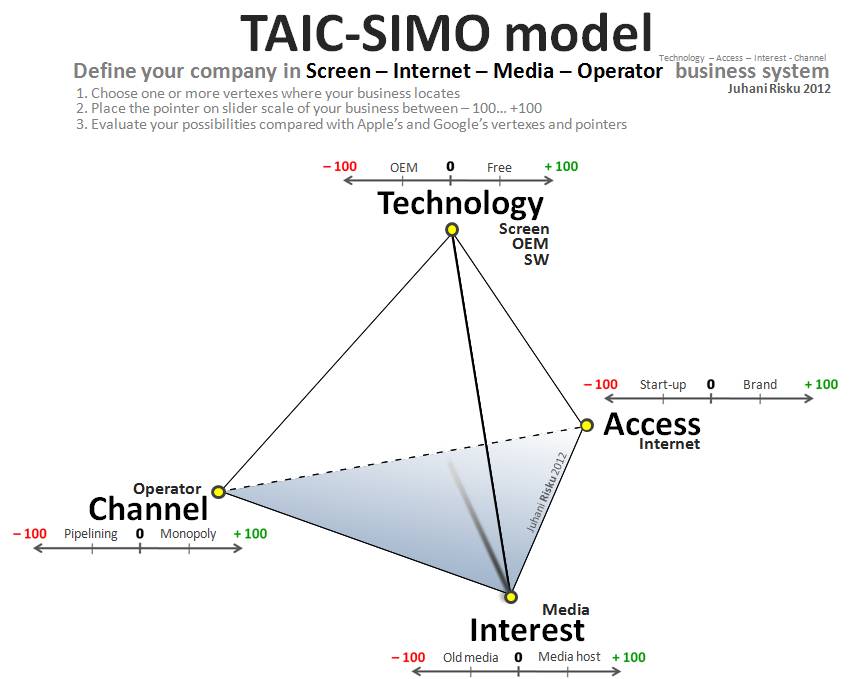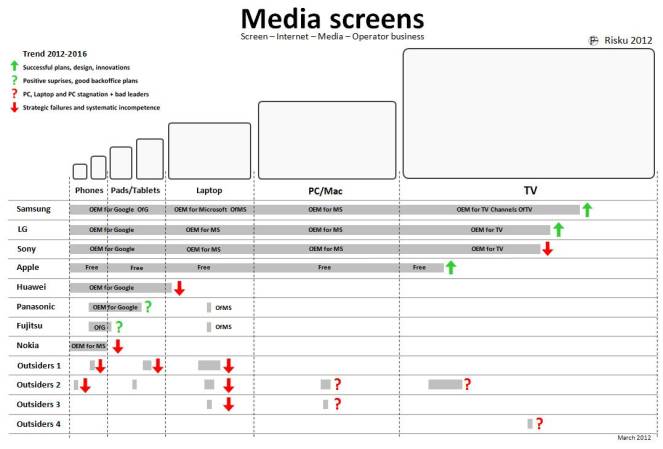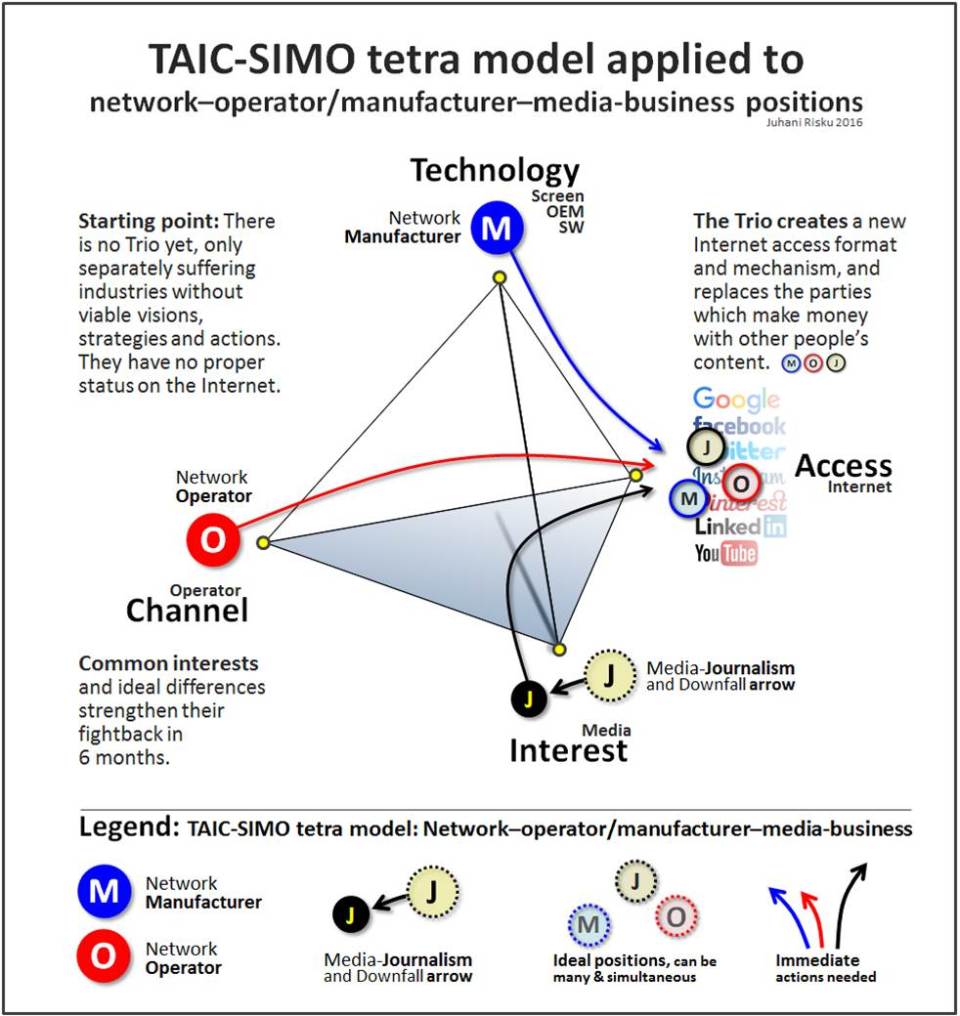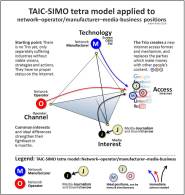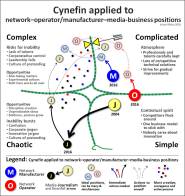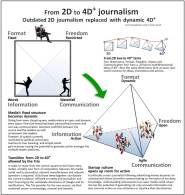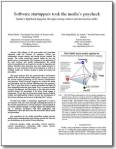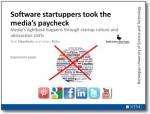An extra complexity factor comes from TAIC-SIMO™ business model. TAIC stands for Technology – Access – Interest – Channel and SIMO for Screen – Internet – Media – Operator. Just when you thought that future device and gadget business is all about inventing and applying new technologies or software development is all about code, agile and lean methods somebody disturbs your comfort zone by telling that the future is logarithmically miraculous. That’s what TAIC-SIMO is about.
Picture “TAIC-SIMO™ business model”, Juhani Risku 2012. Today´s media and ICT businesses has four dimensions: Screen & Internet & Media & Operator businesses SIMO or in other words TAIC Technology – Access – Interest – Channel (SIMO-TAIC™ model PDF). TAIC model equals with SIMO model (Screen – Internet – Media – Operator). If a company dominates all dimensions like Apple or Google they´ll survive. If a company has only one dimension under control like Nokia = Screen, Facebook or Linkedin = Access, Disney or CBS = Interest, Vodafone = Channel, they need to join or form a holistic joint venture to survive. We are going to see fumble actions towards TAIC-SIMO model arrangements (Samsung, IBM, Microsoft…). As an example if you place Nokia in the tetra vertexes and set the right pointer in place you have a company with –50 in Technology-Screen-OEM dimension. Apple has +50…+100 in all four dimensions.
- T = Technology = Screen = Gadget = [easy + pleasant] = [iconic instrument, UI, usability]
- A = Access = Internet oases = [access logic] = [data sort/filter engine, search provider + relevant search result, walled-garden-door-key]
- I = Interest = Media = [content, people, ideas, news, blogs, opinions, literature, music, films, media companies]
- C = Channel = [operators, cable/satellite companies] = [channel/medium/highway].
Combining T+I or S+M (Technology + Interest or Screen + Media) we get the Media Screen chart (below):
Chart Media Screen trends, winners and losers. Today’s screens start from small phones ending up to wide screen TVs. In the near future media screens scale from watchets and glasses to future libraries and future cities. Samsung has the widest portfolio of screens followed by Sony and Apple. Some of the big screen actors have a positive grip to the future. On the contrary, some former big actors have fallen (like Nokia, Blackberry and Motorola).
Today the leading companies in TAIC-SIMO business are Apple and Google, partly Amazon. Microsoft is trying to built its own TAIC-SIMO consortium through Nokia, Yammer, Skype, Office, Windows, Bing and Linkedin. Compared to Apple and Google, Microsoft has all respective components for a B-class system (despite Office, Skype and Linkedin). Verizon is the most potential TAIC-SIMO winner because of the 1) footprint through Vodafone acquire, 2) customer and media base through Yahoo.
People talk about “ecosystems” (which is not so good analogy) but better name for this pervasive business system could be Systemic Media-Technology business environment. Systemic means to include all (ALL) essential dimensions (vertexes) under ownership and governance of one company or consortium. Systemic also means imperative interdependence, impact and linkage to each vertex. In systemic approach you are the winner if all pointers of the sliders are close to +100. This makes all attempts to enter the complete model very difficult. Therefore we have seen HP struggling with Meego and CEO problems as well as Nokia struggling with Symbian, Windows Phone, CEO and CDO problems. When big corporations don’t know what to do, it is called leadership problem, which is normal in global TAIC-SIMO business – there is only a handfull of possible leaders. The first TAIC-SIMO leader was Steve Jobs, the second is Jeff Bezos, third is Brin-Page and there are only four free and available ones left. Mark Zuckerberg never came up to the business and Brin-Page is already falling (as seen on chart “Interest Machine evolution”). Notice that Apple, Google, Sony, old media corporations and telecom operators all need TAIC-SIMO level leaders but only four are competent and available! Companies who need TAIC leaders don’t even listen, understand, believe or care about the future. Lucky them.
TAIC-SIMO business model losers are all mobile carriers (operators) and the Old Media. Mobile carriers turn to plumbers and old media dies in all cases. The most interesting thing is that which ones of the operators and old media corporations start to build their own Systemic Media-Technology consortium. As a guestimate, Orange, Verizon and TeleNor are the active ones not to lose their businesses in front of “the plumbers”. As an example, News Co. and Sony are potential losers because teh giant News Co. loses both relatively and absolotely, and Sony has lost its product creation leadership since the Walkman. Apple seems to share Sony’s faith after Steve Jobs’s era: willpower and leadership left the Apple building.
Design + User Experience = InterestMachine™ + TAIC-SIMO™
Designers and UX professionals are wizards and rainmakers in creating Interest machines and concepting viable TAIC-SIMO models. The only requirement for them is that they join forces and start to be rather first movers than fast followers. Of course the complexity of the machine and TAIC-SIMO are way bigger than any Use Case and Task Flow ever. A totally new modus operandi and leadership model are needed to build 1-2 forerunners for new systemic solutions. It is hard to imagine that any engineer is able to envision and sketch such systems which represent more drama, beauty and meaning than technology and business. This is a well-timed possibility for designers to start to lead technology.
TAIC-SIMO™ applied to media, network manufacturers and network operators
TAIC-SIMO tetra model applied to network–operator/manufacturer–media-business’ (the Trio’s) positions. In the Trio’s fightback they join their forces and build a new format and access to the Internet, and they override today’s advertisement money hijackers. This requires abstraction shifts, startup culture, new leadership and rapid actions from the Trio. The tetra shows direct connections between edges (e.g. O–M collaboration), the tetra face (triangle) show a combined business area (e.g. M–O–J). The missing part of the tetra can be established on a new abstraction level (e.g. M–O–J Internet Access). This MOJ Access is a spin-off of a network–operator/manufacturer–media house consortium. The idea to establish an own Internet Access spin-off instead of acquiring an existing one is about creating a new actor in this business environment. This actor can disrupt the present business models and offer the users and consumers a combination of more interesting and fair services.
Theoretically TAIC-SIMO™ originates from Tetra model
Tetra model is a mechanism to structure phenomena to dimensions. Dimension is a minimum number of needed factors to define a phenomenon. Speed of a car can be defined in 2D and 3D: The speedometer shows the speed in 2D with two factors, meters per hour (MPH). Physically the speed of a car is 3D or larger effect: speed is a scalar factor with speed V (km/h, m/s), direction D (vector) and mass M. Speed V is a 2D scalar, speed V + direction D is a 3D vector V + D. Speed and mass form a 3D variable V + M (force, newton second, kg · m/s, Ns). The car itself acts in 4D+, where V + D + M is a 4D (impulse-momentum, J or Imp), and the plus + consists of several factors from real life like the friction between the wheels and road, driver’s talents, weather and other contextual and human factors.
Each basic scalar like length (meters), time (hours, seconds), mass (kg), direction (°degrees), are 1D scalars τ(0) (here the Tensor τ is differentiated from time T, usually Tensor is marked with T). A 1D scalar is a dimension, a minimum component to define a factor. When combining scalars (dimensions) geometrically or by impact, combinations form 2D, 3D, 4D etc. spaces a.k.a universes.
Tetra model has been iteratively developed from mathematical, physical, natural and human phenomena and structures. Tetra optimises (and minimises) the defining dimensions in a minimum number of needed factors to define a phenomenon. 2 kg of potatoes is in minimum a 2D phenomenon with two scalars, but without dimensions like price, quality, species and purpose (here e.g. altogether 6D).
Mathematically and physically Tetra model scales to any phenomenon from nature to human, from technical and technological to human actions and even to analyse and structure futures, scenarios, trends and evolutionary patterns. Below some examples of Tetra scalability.
Tetra model scales: TAIC-SIMO™ to restructure the media, Tetra(media)
TAIC-SIMO™ is in the core to restructure an annual global business of 1000 billion $US, the media industry. When using the TAIC-SIMO™ as a 4D space of media dimensions, applying the Cynefin framework, and building a “from 2D to 4D+ (or 4Dplus)” workflow, media industry can restructure its future. Notice that only 20-25% of media houses are going to survive, so TAIC-SIMO™ model helps only 1/4 of the companies. The rest wither or die.
Read the paper and presentation of TAIC-SIMO™, Cynefin and from 2D to 4D+, and download the poster, from ICE Conference 2016 in Trondheim Norway 13th June 2016:
Tetra model scales: Human factors to analyse and define Steve Jobs
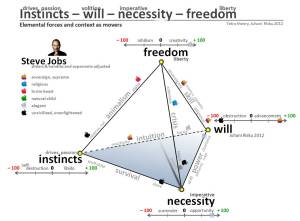
Tetra formula of elemental forces and context as movers, Tetra(human), Case Steve Jobs. Instinct, will, necessity and freedom of Steve Jobs described with a tetra and sliders, handles and exponents adjusted. The Tetra of Steve Jobs allows to understand the nature and meaning of Jobs as a person and leader. When putting e.g. other leaders into their own Tetras with the same dimensions, we can formulate criteria for successful leaders. When putting the Tetra(human) to different contexts like TAIC-SIMO™ or design organisation or government, we get definitions of a great (or bad) leader in minutes.
Case Apple: If Steve Jobs was a perfect person for Apple by his qualities, Tim Cook is missing several features to keep Apple successful. Cook’s creativity dimension is close to zero, his willpower is maximised in supply-chain management, which already is perfect and does not need specifical actions, and his leadership in 2D (instincts + will) is in “engineering mode”, which means zero level intuition to lead Apple to the future. Conclusion: According to Tetra(human) analysis
Tetra model and TAIC-SIMO™ gone wrong
There are several examples of businesses gone wrong when not understanding TAIC-SIMO™ model. There are typically generic reasons to fail when not understanding the Tetra model and its applications like TAIC-SIMO™, Tetra(human) etc.
The main generic reasons to fail in businesses, leadership, technologies, education etc. are:
- You are in wrong business: Microsoft acquired Skype, Yammer, Nokia-Lumia, LinkedIn, Powerset, Wand Labs etc. but has not made any radical, disruptive or successful solutions for mobile devices, search, communication, interaction, AI and design in general. HoloLens as AR/VR is an exception with great future, but time is running out, because Microsoft is far away from e.g. IBM’s Watson, ContextMachine™ of InterestMachine™, and Google’s solutions like StreetView and Search, and the car industry’s solutions. Microsoft is in wrong business when outside Windows OS, MS Office and Server solutions (Tetra(taic-simo)).
- You have a wrong leader: Apple’s Tim Cook can’t lead “Apple as a great product company”. If a janitor with wheelbarrow and bow rake can lead a vineyard, the Apple is going to be a great again. Tetra(human) defines the requirements of the best leader for Apple.
- You stick to wrong technologies: Most of the ICT companies build their businesses on top of technologies and solutions from the 1980’s [binary digits, code, CPU, servers, networks, languages, and M-M-M’s (MMM) Man-Mimicking-Machines. MMM’s have forms of cyborgs and likes of Frankenstein, and they mislead researchers to meaningless and childish solutions. The companies which build systemic solutions and applications on codeless computing, blockchain, liquid software, 4D memories, and stationary computing over binary flow, make the future of ICT and computing] (Tetra(tech)).
- Media houses have wrong partners: The downfall of media and journalism is a combination of Tetra(tech) and Tetra(media) and Tetra(human). Media houses are competing in broadcasting on TV, cable and Web in a zero sum game. Journalists compete by writing better essays and investigative articles when the audience use the Social media and read copied and shortened news only. The media industry has wrong leaders from the 1980’s, they use outdated technologies and solutions, media as a notion is understood like during the paper-printing-machines, and the audience is handled like newspaper readers.
- Your teachers and professors are mediocres: There are 17 000 universities globally, from which over 5 000 teach engineering and 2 500 teach design in all their forms. Not a single (except MIT, Staford and five other) make a difference. The output of 7 495 engineering and design universities is insignificant in research, development and innovation. Conclusion A: Reform at least one university on Earth; Conclusion B: Restructure a network of ten universities globally (Tetra(edu)).
